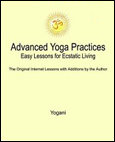|
Public Home | Plus Home | Main Lessons | Tantra Lessons | Public Forum | Plus Forum | Downloads | Books Topic Paths | Search | Training-Retreats | Testimonials | Survey | Interviews | MultiMedia | Contact | Donate |
|
Advanced Yoga Practices Note: For the Original Internet Lessons with additions, see the AYP Easy Lessons Books. For the Expanded and Interactive Internet Lessons, AYP Online Books, Audiobooks and more, see AYP Plus. Lesson 157 - What is Inner Silence? (Audio)
From: Yogani New Visitors: It is recommended you read from the beginning of the archive, as previous lessons are prerequisite to this one. The first lesson is, "Why This Discussion?"
I have also noticed that I frequently start to have vivid mental images during samyama practice. No auditory to disrupt the silence, but clear, dream-quality images. I suspect it means that I'm falling asleep during sadhana, but therein lies another question. Is meditation and samyama performed teetering on the edge between deep relaxation and sleep? Or has mind turned off from the path of sleep and headed in a different direction? A: Inner silence is at the heart of yoga. Without it, there can be no yoga. In the second lesson we discussed how yoga is the joining of the subject (observer) and the object (observed). The object is not so hard to find. It is everything we perceive in our heart and mind, and out through our senses. The object is everywhere. And so too is the subject. But the subject is not always so obvious. The subject is the inner silence we have been talking about here so often. What is inner silence? It has many names in the traditions: sat-chit-ananda, the Self, the witness, unconditioned awareness, the void, emptiness, Father God, Shiva, samadhi, Tao, and so on... In the lessons we often call it pure bliss consciousness. So many names for what amounts to nothingness. But the nothingness is alive. It is aware. It is everywhere. And it is somehow blissful within itself. It is the "I" in you and me that remains constant. It is the universal "I" that expresses as all that we see, yet remains mostly hidden within, except to those who have cultivated Self-awareness through yoga. Success in that cultivation brings a state of freedom from the ups and downs of this world, even as we continue to be involved in our everyday activities. Yoga is about revealing our "I," experiencing it in its native unconditioned state. Yoga is for answering the question "Who am I?" and consciously becoming it. Our nervous system has the ability to give us that experience, and more. This is why the human nervous system is called the "temple of God." With direct experience through practices we can go from the philosophy/theory of inner silence to the reality of it. The leap from theory to reality is found in the ways that our nervous system manifests different forms of awareness. The nervous system operates in modes that we can identify as different states of consciousness. There are three states of consciousness we all know well: 1. Waking state -- what we experience in our daily activity. 2. Dreaming state -- what we sometimes experience in sleep. 3. Deep dreamless sleep state -- what we don't experience much, but we were somewhere. Inner silence is a state distinctly different from these three. We know it in our deep meditation as blissful awareness without any objects. Or it can be mixed with objects too, like thoughts, feelings, or whatever. But in its pristine state, it is without objects. So in yoga it gets its own number as a unique state of consciousness: 4. Inner silence -- it is all those descriptive words and definitions mentioned already. In yoga it is sometimes called simply "Turiya," which means "the fourth state" in sanskrit. The difference between inner silence and the other three states of consciousness is that inner silence is unchanging and can be cultivated in the nervous system as an unending presence superimposed under, in, and through the other three states of consciousness. Those who have meditated for some time find this to be the case. It starts as some inner peace and an awareness of a silent quality coexisting with and within the objects of our perception. This happens with external observations through the senses, and with our thoughts and feelings too. We see them as the objects that they are, occurring external to our unconditioned inner silent awareness. With daily yoga practices, inner silence grows and becomes the the movie screen upon which all our experiences are projected. We become the movie screen -- the infinite movie screen of life. Is inner silence "the space between mental words" (thoughts)? Yes, it is. It is the gap we sometimes experience as we pass from one thought to another, and from one state of consciousness to another. When the music stops for an instant, we are left with inner silence, our Self. For the yogi and yogini, inner silence is also experienced behind and within the thoughts, and within all of life. So, when we let go into inner silence during samyama, there may be no mental activity, or there may be some. If we are letting go, our attention will be in inner silence, assuming we have cultivated some in deep meditation beforehand. Samyama and enlightenment (first stage and beyond) depend on innate inner silence that will be there whether the mind is "burbling" or not. It also comes up in dreaming state and deep sleep -- that's 24/7 inner silence. Once we have that rising, we are becoming ready for serious yoga, union of the subject and the object, and that is the union of the divine poles within us leading to the unity condition where all is experienced as a divine flow of the One. So, the reason why be begin with meditation in these lessons is to cultivate inner silence first, the prerequisite for all the rest that happens in yoga. Once we have that coming up, it is possible to open many doors. When Shiva (inner silence) is there, then arousing and fostering ecstatic union with Kundalini/Shakti becomes possible, and a joyous experience rather than a traumatic one. It is the natural next step. So after meditation is established, that is what we do here in the lessons -- awaken Kundalini and get down to the business of joining the subject and the object. That's yoga. As for falling asleep in samyama, meditation, etc., from the above you can see it is not quite the same as crossing from one state (inner silence) to another state (like sleep). It is not either-or in practices. We can be in both at the same time, which is often the case during meditation especially. That is why we count time we are "lost" in thoughts or no thoughts in meditation as practice time. The purification in the nervous system is going on in these conditions. If we drift off in samyama, we just easily pick up with the sutras where we left off. In that case, we have gone from the sutra off into some blend of inner silence and the subtle flavor of the sutra. When we realize that has happened, we just easily continue from where we left off. The time for getting through samyama can be stretched out a bit if we lose track like that. If something like sleep keeps overcoming us in a particular samyama session, we can just call it done and lie down and rest. This is good samyama also. It can happen if a lot of obstructions are being released. Inner silence is being cultivated throughout the whole procedure, so, again, it is not one state of consciousness or the other. It is rising inner silence with whatever else is going on. Keep in mind that all of this we are talking about is not on the level of the curious mind, the intellect. Only the theory has to do with intellect. The practices are not for promoting theory. Daily advanced yoga practices are for purifying and opening our nervous system in ways that are neurological and biological - a dramatic expansion of the functioning of our nervous system. The experiences of ecstatic bliss that come up are very real - ultimately as real as the most intimate lovemaking we can imagine, and it is all going on inside. So, cultivating inner silence has far-reaching implications in our lives. The guru is in you. Discuss this Lesson in the AYP Plus Support Forum Note: For detailed instructions on deep meditation, see the AYP Deep Meditation book. For detailed instructions on samyama practice, see the AYP Samyama book. Also see AYP Plus.
|
|
|
|
Join the Mail List:
AYP Retreats
eBooks - PDF, EPUB
FREE eBooks with
SAVE with Bundled
|

























